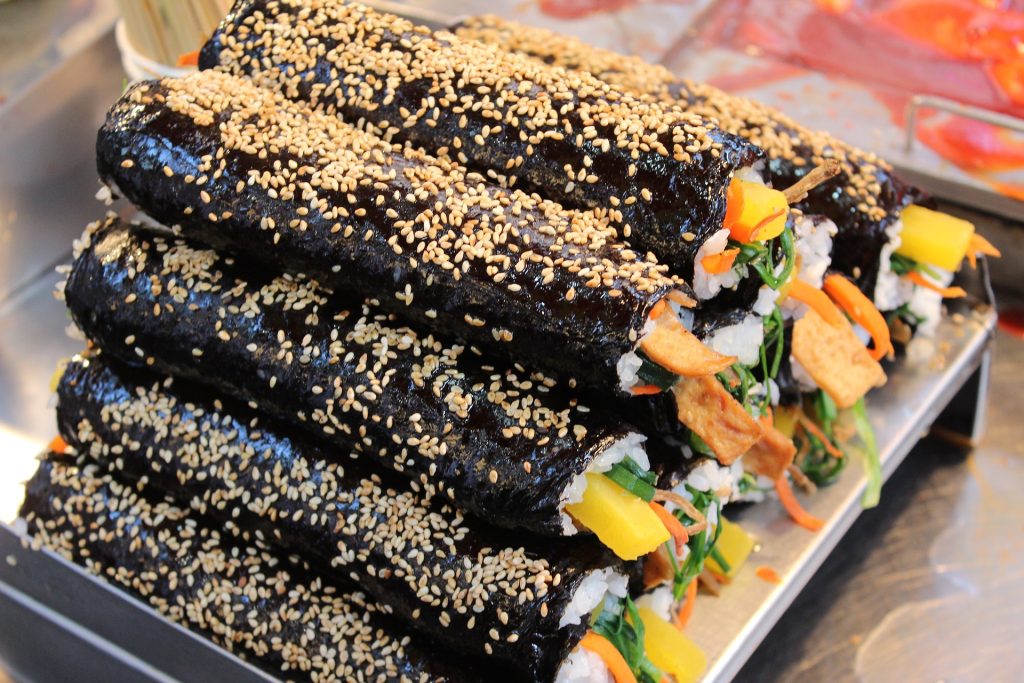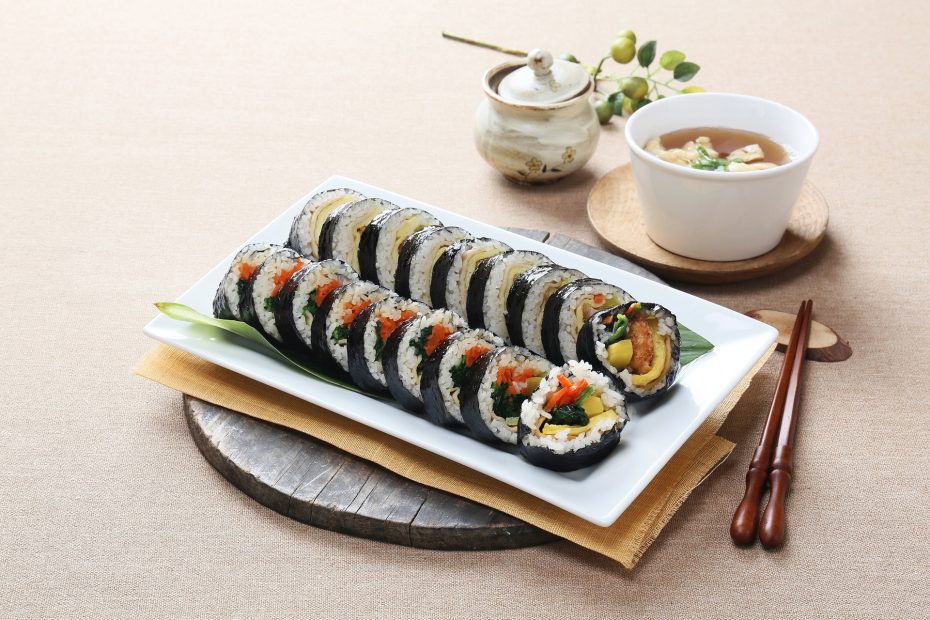Introduction
Kimbap, a beloved Korean dish, is a flavorful and versatile treat that has captured the hearts and taste buds of people worldwide. With its vibrant colors, tantalizing flavors, and a blend of fresh ingredients, kimbap offers a delightful culinary experience that is both satisfying and nutritious.
In this comprehensive guide, we’ll delve into the world of kimbap, covering its origins, easy preparation methods, historical significance, global popularity, appearances in media, renowned Korean kimbap franchises, and more.
Table of Contents:
Contents
- 1 Introducing Kimbap: A Slice of Korea’s Culinary Culture
- 2 Creating Kimbap: A Step-by-Step Guide
- 3 A Brief History of Kimbap: Unraveling the Story
- 4 The Surging Popularity of Kimbap: A Rising Star Among Asian Delights
- 5 Exploring the Fusion of Kimbap and Korean Dramas: A Delightful Connection
- 6 A place where you can eat kimbap
- 7 Conclusion
Introducing Kimbap: A Slice of Korea’s Culinary Culture
Kimbap, often referred to as “Korean sushi,” is a staple in Korean cuisine. This iconic dish is a roll of rice and various ingredients, wrapped in a sheet of seaweed (gim), offering a harmonious blend of flavors and textures. From its humble beginnings as a portable meal for farmers to its current status as a globally enjoyed dish, kimbap has a rich cultural significance that continues to evolve.

https://en.wikipedia.org/wiki/Gimbap
Creating Kimbap: A Step-by-Step Guide
Making kimbap at home is an enjoyable and rewarding experience. With just a few ingredients and some practice, you can master the art of crafting your own kimbap rolls. This section will provide a detailed, beginner-friendly guide to making kimbap, including selecting ingredients, preparing the rice, assembling the rolls, and slicing them into bite-sized pieces.
- gather Your Ingredients: You’ll need sushi rice (seasoned with vinegar and sugar), seaweed sheets (gim), your choice of fillings (like vegetables, cooked meat, and pickled radish), and sesame oil.
- Prepare the Rice: Cook the sushi rice and mix it with a bit of sesame oil for flavor. Let it cool to room temperature.
- Assemble the Ingredients: Place a seaweed sheet on a bamboo sushi mat. Spread a thin layer of rice evenly over the seaweed, leaving a small border at the top.
- Add Fillings: Arrange your chosen fillings in a line across the center of the rice. Be creative – mix and match flavors and textures.
- Roll It Up: Carefully lift the bamboo mat with the edge of the seaweed and rice, and start rolling it away from you. Press gently to shape the roll.
- Seal the Roll: Moisten the top border of the seaweed with a bit of water to seal the roll.
- Slice and Serve: Use a sharp knife to slice the roll into bite-sized pieces. Clean the knife between cuts for neat slices. Serve with soy sauce and enjoy!
A Brief History of Kimbap: Unraveling the Story
Kimbap, a cherished Korean dish, has a rich history that dates back centuries. Originating as a simple and portable meal, kimbap’s evolution reflects Korea’s agricultural heritage and cultural influences.
Historically, kimbap was first created as a convenient sustenance for farmers working in the fields. It consisted of rice, vegetables, and other ingredients rolled in seaweed to provide a hearty and easy-to-carry meal. Over time, kimbap’s popularity grew beyond its humble beginnings, finding its way into Korean homes, markets, and eventually restaurants.
During the early 20th century, kimbap underwent further transformation with the introduction of new ingredients and preparation methods. The dish began incorporating a wider range of fillings, from cooked meats to pickled radish, enhancing its flavor profile. As Korea underwent modernization, kimbap’s accessibility and adaptability ensured its enduring presence in Korean cuisine.
In recent decades, kimbap’s popularity has transcended national borders, captivating international audiences with its delicious taste and cultural significance. As a symbol of Korean culinary heritage, kimbap continues to evolve, embracing both tradition and innovation. Today, it stands as a testament to the enduring power of food to connect people across time and cultures, delighting palates and preserving a flavorful piece of history.
The Surging Popularity of Kimbap: A Rising Star Among Asian Delights
In recent years, the culinary landscape has witnessed a notable shift in the popularity of Asian cuisine, with kimbap emerging as a rising star alongside the well-established fame of sushi. Particularly among foreigners, kimbap’s appeal has been growing steadily, capturing hearts and taste buds around the world. This surge in kimbap’s popularity can be attributed to several factors that make it a unique and enticing culinary experience.
1. Approachable and Flavorful Fusion:
Kimbap’s widespread appeal lies in its harmonious blend of flavors and textures. Unlike sushi, which might be seen as an acquired taste due to its use of raw fish, kimbap offers a more approachable introduction to Korean cuisine. The combination of fresh ingredients, such as colorful vegetables, cooked meats, and pickled radish, creates a palate-pleasing medley that appeals to a diverse range of taste preferences.
2. Customizable and Creative:
Kimbap’s versatility allows for a high level of personalization, making it a canvas for culinary creativity. Foreigners are drawn to the opportunity to experiment with different fillings, flavors, and combinations, adapting kimbap to suit their own tastes. This adaptability has sparked a wave of innovative kimbap variations, from vegetarian options to fusion rolls that incorporate international ingredients.
3. Convenience and Portability:
Kimbap’s origins as a portable meal for on-the-go individuals resonate well with the fast-paced lifestyles of many foreigners. Its compact, ready-to-eat format makes it an ideal choice for lunches, picnics, and quick snacks. The convenience factor, coupled with its delightful taste, has contributed to kimbap’s popularity as a practical and satisfying food option.
4. Social Media and Cultural Exploration:
The power of social media has played a significant role in showcasing kimbap’s aesthetic appeal and cultural significance. As people share their kimbap creations on platforms like Instagram and TikTok, it sparks curiosity and encourages others to explore this iconic Korean dish. Through kimbap, individuals can embark on a journey of cultural discovery and gastronomic exploration.
5. Embracing Healthy Eating:
In an era where health-conscious choices are valued, kimbap offers a balanced and nutritious option. Packed with vegetables, lean proteins, and nutrient-rich seaweed, kimbap aligns well with modern dietary preferences. Its wholesome ingredients and balanced composition contribute to its appeal among those seeking a healthier alternative.
As kimbap continues to make its mark on the global culinary stage, its popularity among foreigners reflects a broader trend of openness to diverse flavors and cultural experiences. With its accessibility, adaptability, and delicious taste, kimbap has rightfully earned its place as a beloved and celebrated Asian delight alongside sushi, captivating food enthusiasts from all corners of the world.
Exploring the Fusion of Kimbap and Korean Dramas: A Delightful Connection
Korean dramas, known for their captivating storytelling and vibrant characters, often weave cultural elements into their narratives. Alongside these beloved dramas, kimbap, a culinary delight, has also found its way onto screens, creating a unique connection between entertainment and gastronomy. Let’s delve into a few notable dramas and films where kimbap takes center stage:
1. “My ID is Gangnam Beauty” (2018):
This heartwarming drama follows the journey of a young woman who undergoes plastic surgery and navigates the challenges of self-acceptance. In one memorable scene, the characters share a heartwarming moment while enjoying kimbap. This portrayal showcases how food, particularly kimbap, can serve as a symbol of comfort and bonding.
2. “Let’s Eat” Series (2013-2018):
This food-centric drama series revolves around the lives of neighbors who share a love for good food. While not exclusively centered on kimbap, these shows emphasize the joy of communal dining and feature various Korean dishes, including kimbap, as integral elements of the characters’ lives.
3. “Weightlifting Fairy Kim Bok-joo” (2016):
In this endearing coming-of-age drama, the main characters share a playful kimbap-making scene, adding a touch of lightheartedness to their blossoming relationship. The scene highlights the cultural significance of kimbap as a shared experience that brings people closer together.
4. “C’est Si Bon” (2015):
While not a drama, this musical film set in the 1960s showcases the Korean music scene of the time. In one scene, characters enjoy kimbap as they discuss their dreams and aspirations, underscoring the role of kimbap as a companion during meaningful conversations.
These dramas and films offer glimpses into the cultural and emotional significance of kimbap in the lives of fictional characters. They highlight how this iconic Korean dish transcends its culinary role to become a representation of connections, shared moments, and the joy of simple pleasures. Whether in moments of introspection, friendship, or romance, kimbap serves as a delightful thread that weaves through the fabric of these captivating narratives.
A place where you can eat kimbap
Convenience stores
In South Korea, convenience stores are more than just places to grab essentials; they’re hubs of culinary delight, and at the heart of this culture is the ubiquitous convenience store kimbap. These delectable rolls are a testament to the fusion of convenience and taste that characterizes Korean urban living.
Convenience store kimbap offers a snapshot of Korean cuisine, compressed into a handy, portable package. With a variety of fillings that range from traditional to contemporary – bulgogi, spicy tuna, kimchi, and more – convenience store kimbap caters to diverse palates and dietary preferences. The meticulous preparation ensures that each roll bursts with flavors and textures, delivering a satisfying experience on the go.
Kimbap in convenience stores isn’t just about sustenance; it’s a cultural phenomenon. Locals rely on these convenient snacks during busy workdays, study sessions, or even as late-night cravings. Foreign visitors, too, are drawn to the allure of authentic Korean flavors available around the clock.
The convenience store kimbap culture goes beyond its culinary appeal; it reflects the fast-paced nature of modern Korean society, where delicious meals can be acquired in mere moments. As you step into a Korean convenience store and unwrap a kimbap roll, you’re not just indulging in a snack – you’re partaking in a slice of Korean life, where taste, convenience, and cultural experiences converge.

Korean Kimbap Franchises: A Taste of Authentic Delights
When it comes to experiencing the essence of Korean cuisine, exploring the diverse offerings of kimbap franchises is an essential culinary journey. These franchises not only showcase the rich flavors and traditions of Korea but also provide a glimpse into the vibrant food culture that defines this remarkable nation. Here are a few renowned Korean kimbap franchises that promise an unforgettable gastronomic adventure:
1. Kimbap Heaven: A true haven for kimbap enthusiasts, Kimbap Heaven offers an extensive menu of kimbap variations to cater to every palate. From classic rolls with traditional fillings to innovative fusion creations, this franchise celebrates the art of customization. With a commitment to quality and freshness, Kimbap Heaven ensures that each bite is a delightful explosion of flavors.
2. Kim’s Kimbap Empire: Stepping into a Kim’s Kimbap outlet is like entering a world of culinary excellence. With its meticulous attention to detail and emphasis on premium ingredients, this franchise has earned a reputation for crafting kimbap that is both visually stunning and delectably satisfying. Whether you’re in the mood for a savory treat or a health-conscious option, Kim’s Kimbap Empire has something for everyone.
3. Seoul Roll & Co.: Seoul Roll & Co. brings a modern twist to traditional kimbap, seamlessly blending innovation with authenticity. The franchise takes pride in offering a wide selection of rolls inspired by global flavors, ensuring a diverse and exciting culinary experience. From sweet and spicy to savory and indulgent, each roll tells a unique story that celebrates the harmony of tastes.
4. K-Fusion Bites: K-Fusion Bites stands at the crossroads of tradition and innovation, curating a menu that captures the essence of Korean cuisine while embracing international influences. This franchise is known for its bold experimentation with fillings and condiments, resulting in kimbap that pushes boundaries and surprises the taste buds in the most delightful ways.
5. Gimbap Express: For those seeking a quick and flavorful kimbap fix, Gimbap Express is the go-to destination. This franchise focuses on providing a convenient and delicious kimbap experience without compromising on quality. From on-the-go professionals to curious tourists, Gimbap Express caters to a diverse clientele with its range of options.
Exploring these Korean kimbap franchises is not just a culinary adventure but an exploration of the rich tapestry of flavors, textures, and traditions that define Korean cuisine. Whether you’re a seasoned kimbap lover or a curious newcomer, these franchises offer a chance to savor the heart and soul of Korea through its most cherished dish.
Conclusion
In the realm of Korean cuisine, kimbap stands out as a flavorful and accessible delight that has captured the attention of food enthusiasts worldwide. Its journey from humble beginnings to international recognition showcases the power of food in connecting cultures and communities. Whether you’re savoring a classic kimbap roll or experimenting with innovative variations, this beloved dish continues to unite people through its delectable flavors and shared experiences. So, embark on your kimbap adventure, and let each bite transport you to the heart of Korea’s culinary heritage.
